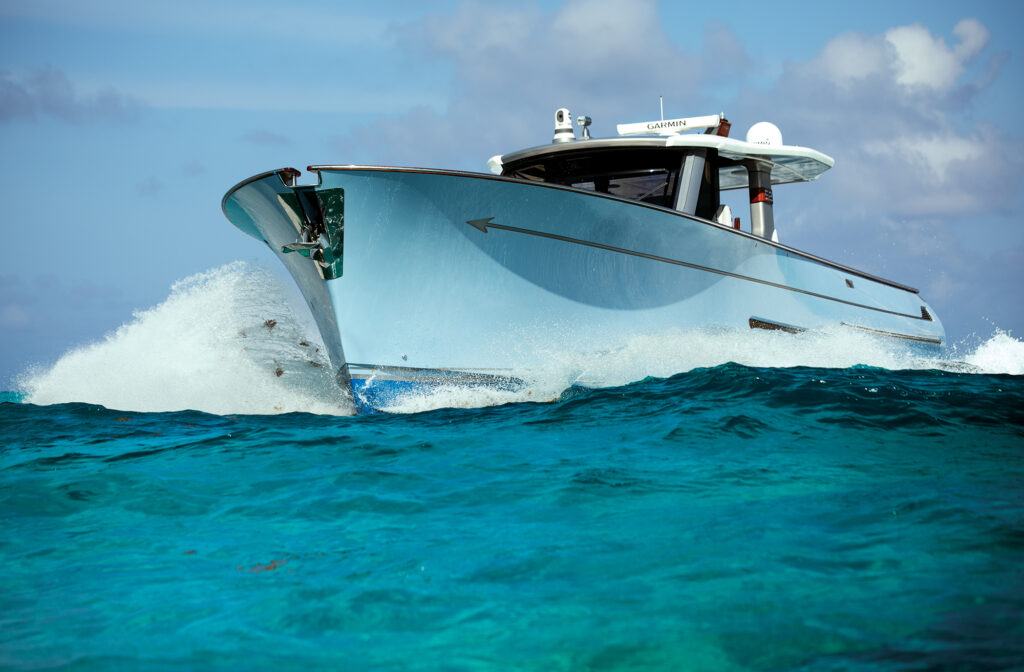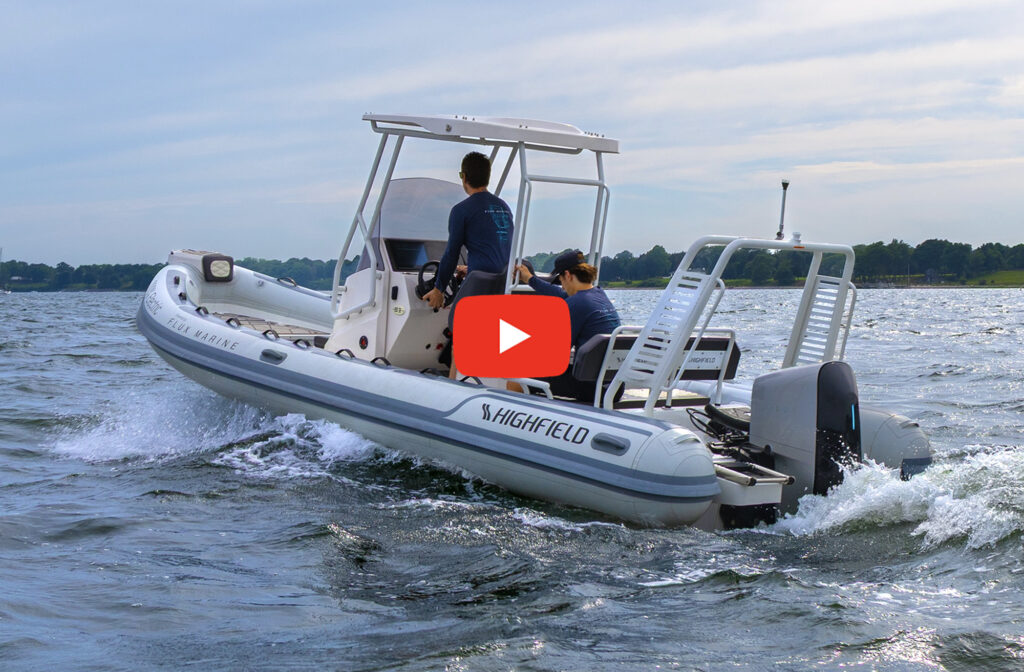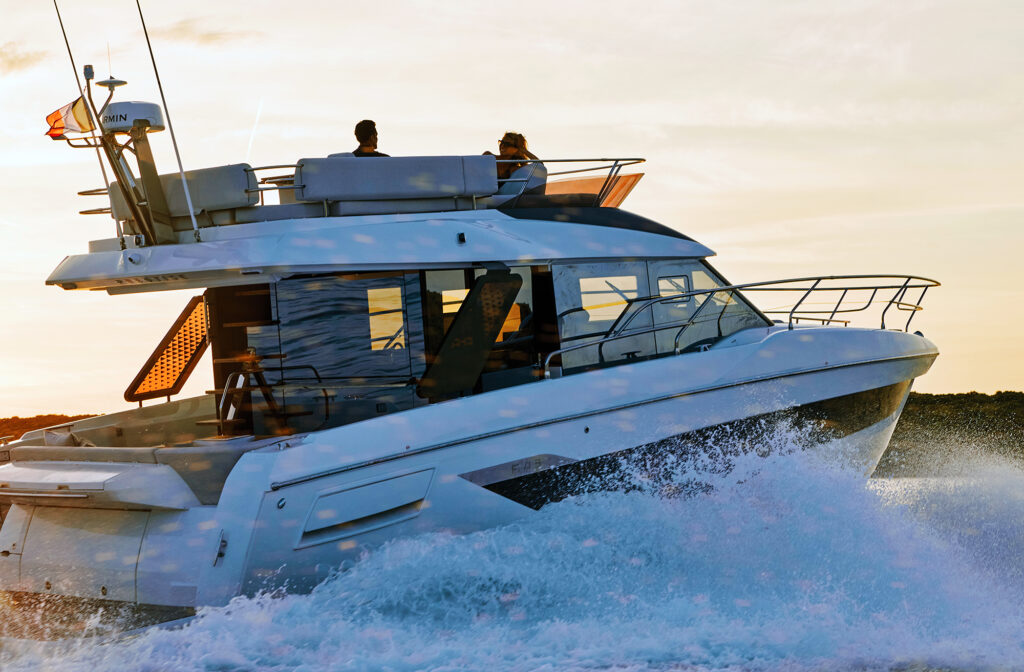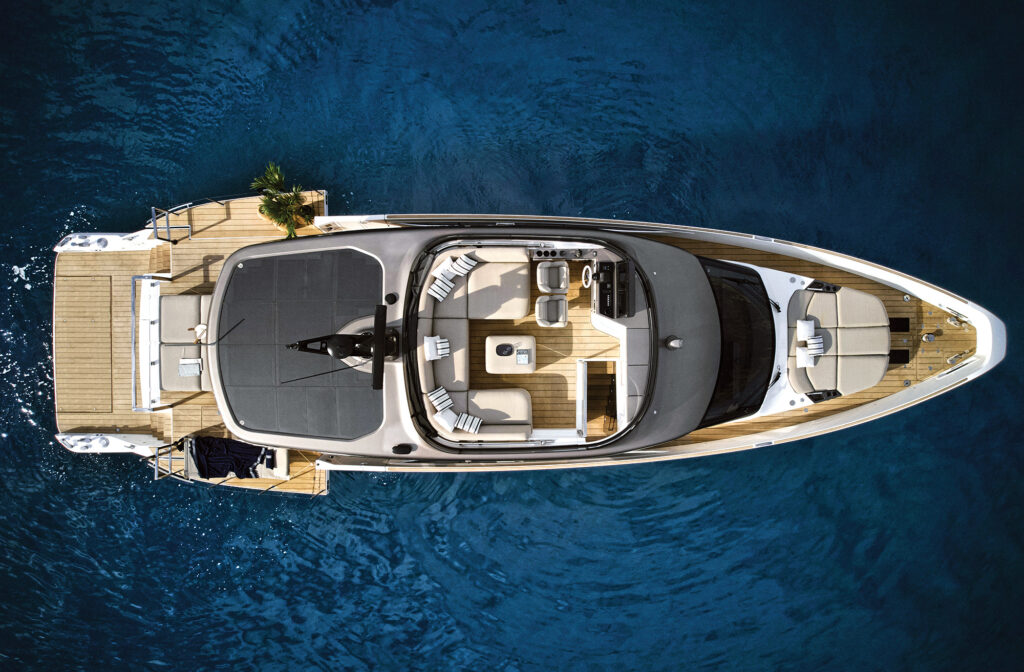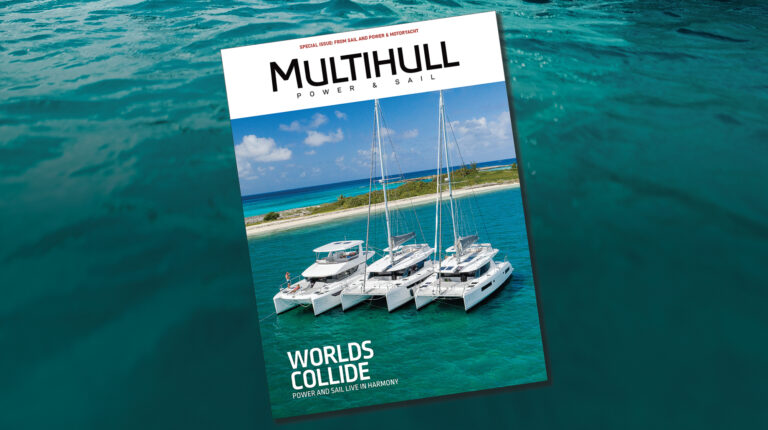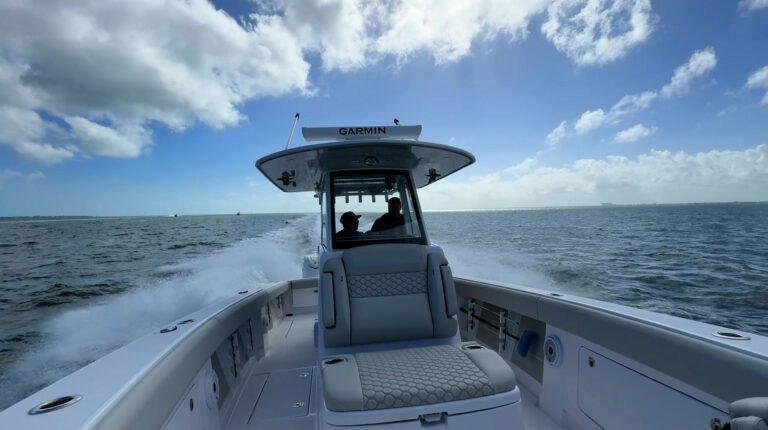Up From The Ashes
Back from near oblivion, Phoenix has a new owner and a 35 convertible as resilient as her namesake.
The Phoenix is synonymous
with rebirth and resiliency: In Greek mythology the bird infinitely repeats
a cycle in which it lives for 500 years, is consumed by fire, and then
miraculously rises from the ashes to live another 500 years. Little did
the original owners of Phoenix Marine know how appropriate this image
would be when they named their company after that storied bird. Now, after
ceasing production last February, this Phoenix has returned to life, thanks
to Carl Herndon, president of Jupiter Marine International, which acquired
Phoenix last year. Herndon is best known for founding Blackfin Yachts
and being president of Bertram Yacht from 1994 to 1996. The first new
Phoenix to emerge from these ashes is the 35 Flybridge Convertible.
It was
January in New York when I got a chance to defrost at the helm of this
reincarnated firebird and see what modifications Herndon had made to bring
her back to life. As my plane accelerated down the runway of Kennedy International
and I left a frozen Big Apple behind, I waved goodbye to all the shivering
city-dwellers.
The
35 is based on the popular Phoenix 34 SFX, which was introduced around
1997 and is the product of a multitude of modifications. For starters,
Herndon says he wanted a more contemporary, rounded, Euro-looking profile,
so he spent six months consulting Phoenix owners and dealers to see how
he could incorporate these features into a legitimate sportfisherman.
The first thing he and his staff did was to remove the 34’s hull
vents, which immediately cleaned up the profile. To ensure the engines
receive an adequate supply of combustion air, the design team replaced
them with hidden scoops in the pilasters containing S baffles (a trick
he used at Blackfin) to prohibit saltwater intrusion and reduce engine
noise. In the 34 the pilasters met the flying bridge overhang at a sharp
angle, so Herndon and the designers rounded off this area and removed
striations in the pilasters to produce a softer look with a lower profile
that looks fast sitting still. They also added about a foot to the foredeck
to make the boat a 35 and lowered and curved the windscreen to further
enhance the streamlined appearance. As a result, this boat is stylish
but still looks like she was built to fish.
In addition
to aesthetics, Herndon also focused on practical changes. He replaced
the balsa coring used in the 34’s hull sides and side decks with
PVC foam coring because, he says, PVC will not rot, and he added glass
from the engine room bulkhead aft to stiffen and reinforce the overall
structure, which added some weight. (Our test boat came in around 23,890
pounds.) He also beefed up the fiberglass-encapsulated stringer system,
which is laid up outside the hull and then installed about two-thirds
of the way through the building process. He also made sure the hull-to-deck
joint is bulletproof, sealing it with 3M 5200, mechanically fastening
it, and then glassing it all around.
Feeling
that the 34 was slightly bow-heavy and looking to enhance its seakindliness,
Herndon moved the center of balance aft about nine inches by repositioning
the genset, engines, and fuel tanks. (After seeing the 35’s back-straight,
lady-like posture at the Cozy Cove Marina in Fort Lauderdale, I’d
say it was the right call.) In the process he also managed to gain 100
gallons of fuel capacity, for a total of 400 gallons. Other handling enhancements
included moving the standard Bennett trim tabs outboard where they could
exert more leverage and increasing rudder size by about 30 percent, improving
helm response.
The
moment I stepped into the 35’s cockpit, I could see Herndon hadn’t
forgotten about fishing. I immediately noticed the standard 30-gallon
in-deck livewell to port and 46-gallon in-deck fishbox to starboard, right
behind the transom door. As a result, you need only drag your catch about
a foot to stow it out of the way. There are also five rod holders (standard)
and ample rod stowage to port and starboard, with benchseating on top
of the engine covers and tackle drawers to either side. Optional amenities
included a half tower, Lee 19-foot, double-box outriggers, and rocket
launchers across the flying-bridge rail.
Herndon
even took fishing into account in redesigning the saloon. While the sole
is carpeted, the flooring beneath it has the same fiberglass nonskid as
the cockpit. So if you don’t want to mess up your interior, just
pull up the carpet and leave it at home. As someone who is admittedly
not always neat when the game is aboard, I particularly like this idea.
Yet
although this is a fishing boat, you could cruise her. The saloon offers
a table with two benchseats to port that can be converted into a double
berth, while the L-shape seating to starboard pulls out to form a bunk.
There is more rod stowage behind the L-shape seating, so you’ll
have room for all your gear aboard the 35. The saloon offers comfortable
6’5″ headroom and is well lit from the cabin side windows. The entertainment
center’s TV, VCR, DVD, and stereo/
CD player
sit conveniently high on the starboard side, with TV viewing equally good
from port or starboard.
If you’re
overnighting or canyon fishing and don’t feel like sacking out in
the saloon, you’ll like the forward stateroom’s queen-size
island berth. A Bomar hatch overhead offers plenty of natural light, and
cedar-lined closets to either side provide good stowage. There is also
dry stowage under the berth. Below that lift another hatch for semidry
stowage. The head with shower to starboard is well lit and comfortably
sized with dry stowage for towels in the shower. (The shower head is aimed
away from this molded-in stowage area, which has a waterproof door sealed
with a gasket.)
The
galley is just as cozy as the sleeping arrangements, thanks to a teak
and holly sole, cabinets with teak inlays, and ample overhead lighting
above the cooking area and counters. There’s also plenty of room
to cook and prepare meals, given the two-burner stove and microwave, deep
stainless steel sink, Sub-Zero refrigerator/freezer, Corian countertops,
plenty of cabinets and drawers, and an optional icemaker.
And
finally, it’s nice to know that Herndon paid attention to the 35’s
engine room. Access is uncomplicated and comfortable, with entrances from
the cockpit and the saloon, the latter available by just pulling back
the carpet and removing a two-foot-square hatch. Inside I had no problem
making my way around the optional twin 420-hp Yanmar diesels. Although
primary access is through the cockpit engine covers/seats, you can access
your salt- and freshwater washdown pumps, alternator, belts, and the like
through here. The area is well lit with three 12-volt fluorescent lights.
But
seeing all of Herndon’s changes was one thing; feeling them was
another. I took the 35 into 10- to 15-mph northwestlies and a two-foot
swell, so I can’t attest to her big-water capability. With her fuel
and water tanks full and three aboard, she made almost 36 mph. I was impressed
with her handling, as she turned easily, rode solid, and took what swells
there were like a champ. The Hynautic steering was smooth, as were the
Panish controls. I liked the optional Glendinning engine synchronizer,
which made moving through rpms a snap. The helm console was clean, even
though Phoenix eliminated the overhead electronics box and put everything
there. Our boat wasn’t short on electronics either, with a Northstar
952XD, Furuno Color Sounder FCV5821, Furuno Radar 1932, Datamarine depth
3001, Simrad autopilot, and Icom VHF. Sightlines were clean over the bow,
whether I was seated in the helm chair or standing. There is seating for
about six in front of the helm.
The
Phoenix 35 Flybridge Convertible is sleek, fast, and was clearly designed
to fish the blue water, although she can be cruised, too. Her dimensions
make her easily handled by a couple. I only wish I had time on her in
more challenging seas to better judge her handling.
The
35 is certainly proof that this Phoenix has risen from the ashes, and
while no one can say if the company will exist for 500 years, right now
its future is burning bright.
Jupiter Marine/Phoenix(954) 525-6314. Fax: (954) 523-9390. www.jupitermarine.com.
Specifications
- Builder: Jupiter
- Model: Phoenix 35
- Year: 2001
- Base Price: $296,950
- Test Engines: 2/420-hp Yanmar 6LY2-STE diesel inboards
- LOA: 36’10”
- Draft: 2’9″
- Beam: 13’2″
- Weight: 23,890 lbs.
- Fuel Capacity: 400 gal.
- Water Capacity: 100 gal.
- Optional Equipment: anchor windlass; Glendinning engine synchronizer; hydraulic engine controls; Lee 19′ outriggers; spreader lights; macerator for fishbox; rod holders on flying-bridge rail; arch-style half tower; 3-side weather enclosure; console cover; teak and holly sole; icemaker; reverse-cycle A/C
- Standard Power: 2/370-hp Cummins 6BTA diesel inboards
- Optional Power: 2/450-hp Cummins 6BTA or 2/450-hp Cummins 6CTA diesel inboards; 2/385-hp or 2/420-hp Caterpillar 3126 diesel inboards; 2/420-hp Yanmar 6LY2-STE diesel inboards.
- Props: 20 x 22 4-blade Nibral
- Transmission: ZF 1.78:1
- Steering: Hynautic hydraulic
- Controls: Panish
- Standard equipment: coaming padding; freshwater wash down; insulated fishbox; livewell; transom door; 5-rod holders; two-burner cooktop; microwave; refrigerator/freezer; convection oven; dual-lever controls; flush-mounted electronics panel
This article originally appeared in the March 2001 issue of Power & Motoryacht magazine.


